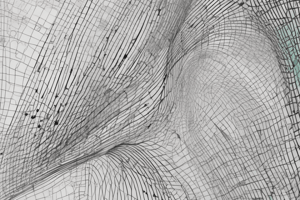Podcast
Questions and Answers
What is the primary condition for a function to have an inverse that is also a function?
What is the primary condition for a function to have an inverse that is also a function?
- The function must be continuous
- The function must be one-to-one (correct)
- The function must be non-linear
- The function must be many-to-one
What is the graphical representation of a function and its inverse?
What is the graphical representation of a function and its inverse?
- They are symmetrical about the line y = x (correct)
- They are asymmetrical
- They are symmetrical about the y-axis
- They are symmetrical about the x-axis
What does the notation f^(-1)(x) indicate?
What does the notation f^(-1)(x) indicate?
- The reciprocal of f(x)
- The inverse function (correct)
- The square root of f(x)
- The derivative of f(x)
How do you find the inverse function of a given function?
How do you find the inverse function of a given function?
What is the purpose of the horizontal line test?
What is the purpose of the horizontal line test?
What is the relationship between a function and its inverse?
What is the relationship between a function and its inverse?
If a function is many-to-one, what can be said about its inverse?
If a function is many-to-one, what can be said about its inverse?
What is the result of applying a function and its inverse in succession?
What is the result of applying a function and its inverse in succession?
Why is the graphical symmetry of a function and its inverse important?
Why is the graphical symmetry of a function and its inverse important?
What is the significance of the horizontal line test?
What is the significance of the horizontal line test?
What happens when you interchange x and y in the equation y = f(x)?
What happens when you interchange x and y in the equation y = f(x)?
What is the relationship between the graphs of a function and its inverse?
What is the relationship between the graphs of a function and its inverse?
Which of the following statements about inverse functions is false?
Which of the following statements about inverse functions is false?
What is the consequence of a function failing the horizontal line test?
What is the consequence of a function failing the horizontal line test?
Why is it important to check if a function is one-to-one before finding its inverse?
Why is it important to check if a function is one-to-one before finding its inverse?
What is the purpose of solving for y when finding the inverse of a function?
What is the purpose of solving for y when finding the inverse of a function?
What is the relationship between the graphs of a function and its inverse when reflected across the line y = x?
What is the relationship between the graphs of a function and its inverse when reflected across the line y = x?
What is the result of applying a function and its inverse in succession, with the original input being x?
What is the result of applying a function and its inverse in succession, with the original input being x?




